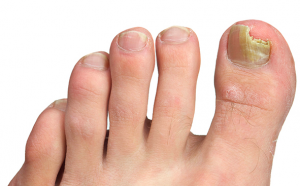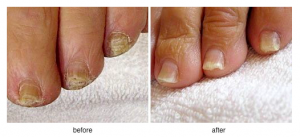 Fungal nail infections are one of the most common diseases of the nails, making up approx. 50 percent of nail abnormalities. Whilst Fungi are normally present in and on the body alongside various bacteria. When a fungus begins to overgrow, this is when you can get an infection.
Fungal nail infections are one of the most common diseases of the nails, making up approx. 50 percent of nail abnormalities. Whilst Fungi are normally present in and on the body alongside various bacteria. When a fungus begins to overgrow, this is when you can get an infection.Both fingernails and toenails are susceptible to infection however, the condition most commonly occurs in toenails – which usually presents as discolouration and thickening of the nail, and crumbling edges. Fungal infections develop over time, so any immediate difference in the way your nail looks or feels may be too subtle to notice at first.
Why Does It Develop?
A fungal nail infection occurs from the overgrowth of fungi in, under, or on the nail. Fungi thrive in warm, moist environments, so this type of environment can cause them to naturally overpopulate.
Tips for preventing fungal nail infections
Always clean in between your fingers and toes and keep your feet and hands dry as moisture can aid the fungal spores spreading.
- Wear thongs around swimming pools and public showers.
- Don’t share your personal items like towels and sports clothes.
Ask your nail salon if the towels and equipment are sterilised and properly cleaned.
What Does It Look Like?
A fungal infection of the nail may affect part of the nail, the entire nail, or several nails.
Common Signs
Common signs of a fungal nail infection include:
- Scaling under the nail, which is called subungual hyperkeratosis
- White or yellow streaks on the nail, which is called lateral onychomycosis
- A crumbling corner or tip of the nail, which is called distal onychomycosis
- Flaking white areas on the nail’s surface, which may include pits in the nail
- The appearance of yellow spots at the bottom of the nail, which is called proximal onychomycosis
- Distorted nail that may lift off from the nail bed
- Odor coming from the infected nail
- Brittle or thickened nail
How to treat fungal nail infections
ClearSteps™ is an effective, safe, non-surgical and virtually painless procedure using an Nd:YAG laser. It eliminates onychomycosis by killing the fungus responsible for the condition. ClearSteps™ is a simple walk-in and walk-out procedure, with no down time required.
 ClearSteps™ involves the application of laser energy to the nails. The laser light specifically targets fungal elements, heating and destroying the fungus in the process. All nails, not just those affected, are treated because fungus might still be present in normal looking nails.
ClearSteps™ involves the application of laser energy to the nails. The laser light specifically targets fungal elements, heating and destroying the fungus in the process. All nails, not just those affected, are treated because fungus might still be present in normal looking nails.
Four treatment sessions, one week apart are required to ensure elimination of all fungal particles.
There will be no apparent result immediately, but normal looking nails should grow out over a six to twelve month period.

